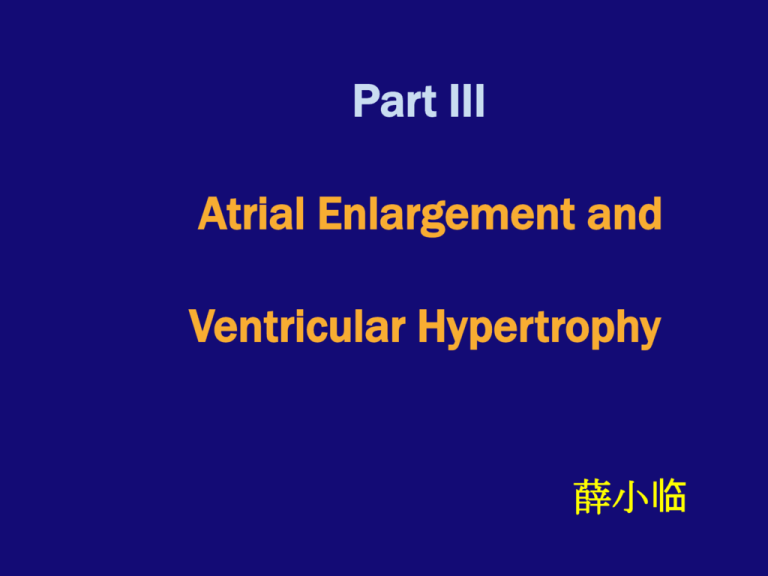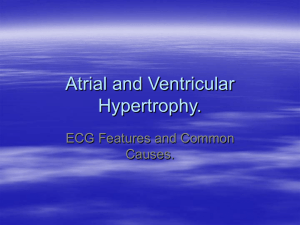Atrial Enlargement and Ventricular Hypertrophy
advertisement

Part III Atrial Enlargement and Ventricular Hypertrophy 薛小临 (1) Left Atrial Enlargement Lead II Duration of P wave ≥0.12 sec. ; P wave become bifid (P "mitrale"); The distance of two peak ≥ 0.04sec. Lead V1 P wave become biphasic; Ptfv1 - 0.04 mm·sec Right Atrial Enlargement Lead II P wave is peaked (P "pulmonale"); Amplitude of P wave ≥0.25 mV in limb leads. Biatrial Enlargement Lead II P wave duration and amplitude both increased. Left Ventricular Hypertrophy A. Increased voltage SV1 + R V5 >3.5mV (female), 4.0mV (male); Rv5 or Rv6 > 2.5 mV; RI > 1.5mV; RaVL > 1.2mV; RaVF > 2.0 mV; RI + SIII > 2.5 mV; B. Left axis deviation C. ST depression and T inversion in V5-6. Right Ventricular Hypertrophy A. Increased voltage (adults over 30) R/S ratio in V1 > 1.0; R/S ratio in V5 or V6 ≤ 1.0; R/q or R/S ratio in aVR≥1; R V1+ S V5 >1.05mV (severe>1.2mV); RaVR>0.5mV; B. Right axis deviation ≥ +900 (severe > +1100). C. ST depression and T inversion V1-2. Biventricular Hypertrophy A. Normal ECG. B. One ventricular hypertrophy. C. Biventricular Hypertrophy. Part VI Myocardial Ischemia and Myocardial infarction ECG of myocardial ischemia shows: ST segment depression; ST segment elevation( coronary spasm); Inverted, diphasic, low T wave. Myocardial infarction (1) Basic changes “Hyperacute” T Waves. Tall peaked T waves, often appear as the earliest ECG sign of acute MI. ST Elevations. The ST segment elevated in one or more leads and may be straightened and fuse with the T wave (mono-phasic curve) Pathologic Q Waves. the sudden developed Q wave may indicate an acute MI. T Wave Changes. The elevated ST segments return to the baseline, and deep symmetrical T waves appear in these leads. Tall, symmetrical, upright T waves will appear in reciprocal leads at the same time. (2) Progressive ECG changes (3) Localization of the ECG patterns Leads with Abnormal Q Waves in MI Leads with Abnormal Q Waves location of MI V1 V3 Anteroseptal V3 V5 Anterior I, aVL, V5 V6 Lateral V1 V6 Extensive Anterior II, III, aVF Inferior (4) Old myocardial infarct A definitive diagnosis of old myocardial infarct depends on the presence of a pathological Q wave






